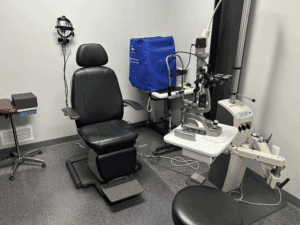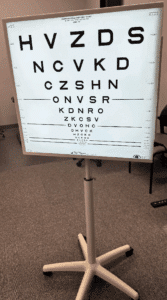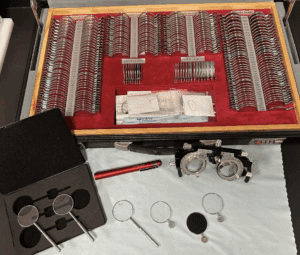About Clinical Trials
What is a clinical trial?

Clinical trials of drugs advance through four phases. The FDA typically requires phase I, II, III trials to be conducted to determine if the drug can be approved for use.
A Phase I trial – tests an experimental treatment on a small group of often healthy people (20-80). Before a Phase 1 trial can be done, the study drug has been tested on animals and is found to be safe. In a Phase 1 trial the drug is tested for the first time in humans. For this reason, a very small dose is tested first, often on healthy people. The dose is slowly increased to make sure that there are no significant side effects until a dose where a treatment response is seen.
A Phase II trial – involves more people (100 to 300). While the emphasis in Phase I is on safety, the emphasis in Phase II is on effectiveness. This phase aims to obtain preliminary data on whether the drug works in people who have a certain disease or condition. These trials also continue to study safety, including short-term side effects. This phase can last several years.
A Phase III trial –gathers more information about safety and effectiveness, studying different populations and different dosages, using the drug in combination with other drugs. The number of subjects usually ranges from several hundred to about 3,000 people. If the FDA agrees that the trial results are positive, it will approve the experimental drug or device.
A Phase IV trial– is for drugs or devices that the FDA has already approved. A device or drug’s effectiveness and safety are monitored in large, diverse populations. Sometimes, the side effects of a drug may not become clear until more people have taken it over a longer period of time.
Why participate in a clinical trial?

Other reasons you want to consider when deciding if you want to be in a clinical study for your retinal diseases are:
- Medication is covered for the study eye that is being investigated. Many times, the other eye is also treated and covered by the study.
- Most studies offer a stipend ranging from $25 – $100 per visit.
- Most studies will provide travel reimbursement for your visits.
Here’s what happens in a trial:
- Study staff explain the trial in detail and gather more information about you.
- Once you have had all your questions answered and agree to participate, you sign an informed consent form.
- You are screened to make sure you qualify for the trial.
- If accepted into the trial, you schedule a first visit (called the “baseline” visit). The researchers conduct tests and take different scans during this visit.
- You are randomly assigned to a treatment or control group.
- You and your family members follow the trial procedures and report any issues or concerns to researchers.
- You may visit the research site at regularly scheduled times for evaluations and discussions with staff. At these visits, the research team collects information about effects of the intervention and your safety and well-being.
- You continue to see your regular physician for usual health care throughout the study.
Active and Currently Enrolling
Studies for Diabetics
Elevatum-Ml43435 Study
A PHASE IIIB/IV, MULTICENTER, OPEN-LABEL, SINGLE-ARM STUDY TO INVESTIGATE FARICIMAB (RO6867461) TREATMENT RESPONSE IN TREATMENT-NAÏVE, UNDERREPRESENTED PATIENTS WITH DIABETIC MACULAR EDEMA
Length of study – 61 weeks
Inclusion Criteria : Correct ethnicity; Black/African American, Hispanic/Latino American, or Native American/Alaska Native/Native Hawaiian or other Pacific Islander, 18 y.o or older, treatment naïve(meaning on previous laser or intravitreal injections), diagnosed with DM type I or II that is being treated with medication, Diagnosed with DME(diabetic macula edema) – >325 CST/OCT, have a hemoglobin A1C<=10%, BCVA ETDRS score 20-73(which is 20/20 to 20/100), clear ocular media, female not pregnant.
Exclusion Criteria: High risk PDR/VH/NVE/RI, Uveitis, any Glaucoma surgery, Cataract surgery within last 3 months, cancer or CVA within past year, uncontrolled blood pressure >180/100, pregnant or breastfeeding, renal failure, NO laser or IV injections or use of corticosteroids, Non-study eye- hand motion vision or blind.
For this study there is 1 arm of treatment:
- Intravitreal Faricimab (which is FDA approved for DME) , 1 injection every 4 weeks up to week 20 then 1 injection every 8 weeks till week 52.
Link for the study: https://www.youtube.com/watch?v=gCEgAyYGz3o
PREGONDA – BP44175 PART 2
A MULTICENTER, NON-RANDOMIZED, OPEN-LABEL, MULTIPLE ASCENDING DOSE STUDY TO INVESTIGATE THE SAFETY, TOLERABILITY, PHARMACOKINETICS AND PHARMACODYNAMICS OF RO7497372 FOLLOWING INTRAVITREAL ADMINISTRATION IN PARTICIPANTS WITH DIABETIC MACULAR EDEMA
Part 2 of a Phase I, multipart, multicenter study to investigate the safety, tolerability, pharmacokinetics and pharmacodynamics of R07497372 following intravitreal administration in participants with diabetic macular edema.
The purpose of this research study is to examine the effects,of two doses of RO7497372 (low dose and high dose.
A phase I clinical trial that is investigation the effects of “R07497372” in people with diabetic macular edema(DME). “R07497372” is a drug which inhibits two targets at the same time – one target is a contributor to inflammation and the other a contributor to vessel growth and fluid accumulation in the retina.
Length of study- 36 weeks
Inclusion Criteria:
The study is available to people over 18 years of age who have diabetes, type I or type II, for which they take oral or injectable medication or are on diet control. Diagnosed with Macular thickening secondary to DME involving the center of the fovea with central subfield thickness (CST) ≥ 325, BCVA primarily due to DME with ETDRS score of 78 to 19 letters (both inclusive)
Exclusion Criteria:
Proliferative Diabetic Retinopathy, uncontrolled glaucoma, aphakia or intraocular lens outside the capsular bag, any active inflammation in the eye, Uncontrolled BP, HbA1c>12
Patients are assigned into a group depending on the Cohort that is enrolling. Each group will receive a different dose. A patient will receive a total of 3 injections, spaced 4 weeks apart.
Studies for Macular Degeneration
RGX-314-3101-Ascent study (1 year study that uses Eylea as the control medication)

RGX-314 is an investigational adeno-associated virus(AAV) gene therapy being developed as a potential treatment for patients with neovascular age-related macular degeneration (nAMD, also known as “wet” age-related macular degeneration [AMD]) and for patients with diabetic retinopathy
RGX-314-2104 Atmosphere study(2 year study that uses Lucentis as the control medication)
This is a randomized, partially masked, controlled, phase 2b/3 clinical study to evaluate the efficacy and safety of RGX-314 Gene Therapy in participants with neovascular Age Related Macular Degeneration or wet AMD. The purpose of this study is to evaluate whether two different doses of RGX-314 help improve or preserve vision compared to Lucentis®. In this study, you will either receive RGX-314 or only Lucentis®. This is a 98 week long study.
DRCR Protocol AO: Home OCT-Guided Treatment versus Treat and Extend for the Management of Neovascular AMD
Treatment of neovascular AMD (nAMD) with anti-VEGF therapy is highly effective but is associated with considerable treatment burden and cost for patients and the healthcare system. One of the principal barriers to reducing burden and cost is that both the optimal timing and the optimal number of injections needed to achieve best visual acuity and disease control for any one person are unknown. At present, there are several algorithms that modestly reduce treatment burden, but at the expense of overtreatment in some patients and less optimal disease control in others. The lack of precision in disease management may be due in part to the low frequency of disease monitoring, which typically occurs every one to two months by standard OCT imaging during an office visit. Home OCT imaging allows daily disease activity monitoring and the possibility of a tailored and more personalized approach to managing neovascular AMD. This is a randomized clinical trial that compares visual acuity outcomes, and visit and injection frequencies, obtained using a Home OCT-guided treatment strategy versus outcomes obtained using Treat and Extend, the treatment algorithm widely perceived to be the most common regimen in clinical practice today.
LUGANO (EYP-1901-301) and LUCIA (EYP-1901-302)
Studies for Epi-Retinal Membrane
DRCR protocol AM: Randomized Trial Comparing Immediate versus Deferred Surgery for Symptomatic Epiretinal Membranes
Vitrectomy to remove an epiretinal membrane (ERM) is one of the most common procedures performed by retinal surgeons. Patients who present with significant macular changes on optical coherence tomography (OCT) but relatively good vision are often advised to defer surgery until vision declines to 20/40 or worse. However, it is unknown if delaying surgery, which allows the foveal architecture to remain compromised and potentially to deteriorate, results in worse visual acuity outcomes than if surgery is performed earlier. In addition, there is a need to better understand predictors of outcomes when surgery is performed and predictors of progression when surgery is deferred. Finally, one of the most common presenting symptoms from an ERM is distortion or metamorphopsia. There are several objective measures of metamorphopsia, but none have been employed to evaluate ERMs in a randomized clinical trial (RCT) and their usefulness is unknown. The purposes of this study are to better understand the optimal timing of surgery to produce the best visual result, to better understand predictors of outcomes in those who undergo surgery and predictors of progression in those whose are observed, and to better characterize and evaluate the usefulness of metamorphopsia and reading speed measures.
Studies for Geographic Atrophy
“ASTELLAS-REVEAL: A NON-INTERVENTIONAL, OBSERVATIONAL STUDY TO EVALUATE TREATMENT PATTERNS AND SAFETY OF AVACINCAPTAD PEGOL (ACP/IZERVAY™) IN ROUTINE CLINICAL PRACTICE IN PATIENTS WITH GEOGRAPHIC ATROPHY SECONDARY TO AGE-RELATED MACULAR DEGENERATION.
If you decide to take part in this research study, the general procedures include collection of your medical history, medications and procedures from approximately 5 years before starting treatment with IZERVAYTM and during treatment follow-up. At some visits, you will be asked questions about your vision.
This study is being done to better understand patient experiences, treatment, management and safety of geographic atrophy (GA) secondary to age-related macular degeneration (AMD) when treated with IZERVAYTM eye injections.
Your participation in the study will depend on how long you are treated with IZERVAYTM but will not be longer than 3-5 years from when you sign the consent form. Your participation may continue even if you end treatment with IZERVAYTM.
Prior Studies
Studies for Uveitis
YUTIQ – calm (EYP-YUT-0001)
This is a Phase IV retrospective registry study to collect Real-World Data on YUTIQ, a Fluocinolone Acetonide Intravitreal Implant, for the treatments of chronic non-infectious Uveitis affecting the posterior segment.
This is a retrospective study, a database will be compiled of up to 500 patients who have been treated with YUTIQ at up to 50 sites. Routine standard of care ocular assessments (eg, visual acuity [VA], intraocular pressure [IOP], measurements from optical coherence tomography [OCT]), and adverse events may be collected from routine visits over 5 years.
Inclusion; patients with chronic, non-infectious uveitis affecting the posterior segment of the eye, and men /women >= 18 years old.
Exclusion; patients with contraindications per US prescribing information, eg-active or suspected ocular or periocular infections including most viral diseases of the cornea and conjunctiva. Patients with known hypersensitivity to any components of YUTIQ. Pregnant and/or nursing women. Concurrent participation in another study involving an investigational drug or device.
Studies for Diabetics
OPI-APXDR-201 ZETA-1 – Randomized, Placebo-Controlled, Double-Masked Study of the Safety and Efficacy of Orally Administered APX3330 in Subjects with Moderately Severe to Severe Non-Proliferative Diabetic Retinopathy or Mild Proliferative Diabetic Retinopathy. Closed
New Day Study – A phase IV, randomized, masked, controlled study of Intravitreal Iluvien Implant as baseline therapy in patients with Early Diabetic Macular Edema (DME). Closed
VALO – OPL-0401-201 – SPECTRA STUDY – This is a Phase 2 study to evaluate the safety and efficacy of OPL-0401 in patients with non-proliferative diabetic retinopathy. Closed
Studies for Macular Degeneration
TELESCOPE: A STUDY TO IDENTIFY THE LOCATION OF ATROPHY AND GENETICALLY DEFINE SUBJECTS WITH GEOGRAPHIC ATROPHY SECONDARY TO AGERELATED MACULAR DEGENERATION.
HORIZON: A PHASE II, OPEN-LABEL, OUTCOMES-ASSESSOR MASKED, MULTICENTRE, RANDOMISED, CONTROLLED STUDY TO EVALUATE THE SAFETY AND EFFICACY OF TWO DOSES OF GT005 ADMINISTERED AS A SINGLE SUBRETINAL INJECTION IN SUBJECTS WITH GEOGRAPHIC ATROPHY SECONDARY TO DRY AGE-RELATED MACULAR DEGENERATION. Closed
EXPLORE: A PHASE 2, OUTCOMES ASSESSOR-MASKED, MULTICENTRE, RANDOMISED STUDY TO EVALUATE THE SAFETY AND EFFICACY OF TWO DOSES OF GT005 ADMINISTERED AS A SINGLE SUBRETINAL INJECTION IN SUBJECTS WITH GEOGRAPHIC ATROPHY SECONDARY TO AGE-RELATED MACULAR DEGENERATION. Closed
Acronyms
Acronyms
AMD – age-related macular degeneration
nAMD – neovascular age-related macular degeneration
CNV – choroidal neovascularization
NPDR – non-proliferative diabetic retinopathy
PDR – proliferative diabetic retinopathy
DME – diabetic macular edema
CI-DME – center involved diabetic macular edema
NVE – neovascularization elsewhere
PRP – panretinal photocoagulation
DM – diabetes mellitus
IVT – intravitreal triamcinolone
VMT – vitreomacular traction
VH – vitreous hemorrhage
RI – rubeosis iridis
C/D ratio – cup to disc raio
OHT – ocular hypertension
IOL – intraocular lens
BCVA – best corrected visual acuity
ETDRS – early treatment diabetic retinopathy study – this is a standardized research chart
CST – central subfield thickness
Contact us for more details


